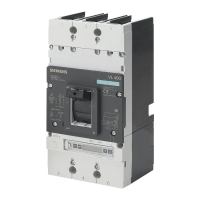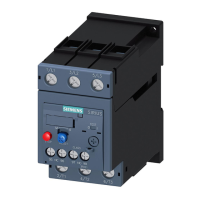Product description
3.3 Configuration
3VL IEC molded case circuit breakers
24 System Manual, 11/2013, 110 0110 - 02 DS 03
The magnetic release comprises a yoke mounting through which a current path runs, and a
flap armature that is kept at a distance from the yoke mounting by a tension spring. If a
short-circuit current now flows along the current path, the magnetic field thus generated
causes the flap armature to be moved towards the yoke mounting against the opposite force
of the tension spring. The release time is almost current-independent and instantaneous.
The flap armature releases the switching lock and thus opens the switching contacts before
the short-circuit current can reach its maximum; a current limiting effect is thus achieved.
Immediately after release, the flap armature is moved back to its starting position by the
opposite force of the tension spring.
Electronic overcurrent trip unit (ETU)
Electronic trip units (ETUs)
In contrast to thermal-magnetic releases/trip units (TMTUs) where the overcurrent trip is
caused by a bimetal strip or magnetic release, electronic trip units (ETUs) use electronics
with current transformers. The ETU captures the actual currents and compares them with the
default specifications.
All 3VL molded case circuit breakers with electronic overcurrent trips measure the actual
RMS current (true RMS). This is the most accurate method of measuring.
ETUs are available from the VL160 molded case circuit breaker up to and including the
VL1600. The VL800, VL1250 and VL1600 molded case circuit breakers are only available in
the version with electronic trip unit.
The electronic overcurrent tripping system consists of:
● 3 to 4 (3-pole or 4-pole) current transformers that also provide their own power supply.
This means an external auxiliary voltage is not required.
● Evaluation electronics with microprocessor
● Tripping solenoid
In all versions with electronic trip units for the 3VL molded case circuit breakers, the current
transformers are located in the same enclosure as the trip unit. At the output of the electronic
overcurrent tripping module, there is a tripping solenoid that trips the molded case circuit
breaker in the event of an overload or short-circuit. In all electronic trip units, the tripping
solenoid is located within the trip unit, except in the shipbuilding ETUs of sizes VL160 and
VL250. In these ETUs, the tripping solenoid is located in the left accessories compartment.
The protection functions of the electronic trip unit are guaranteed without additional auxiliary
voltage. The overcurrent releases are supplied with energy via internal current transformers.
The protection function is set via rotary encoding switches on the ETU or via an LCD display.

